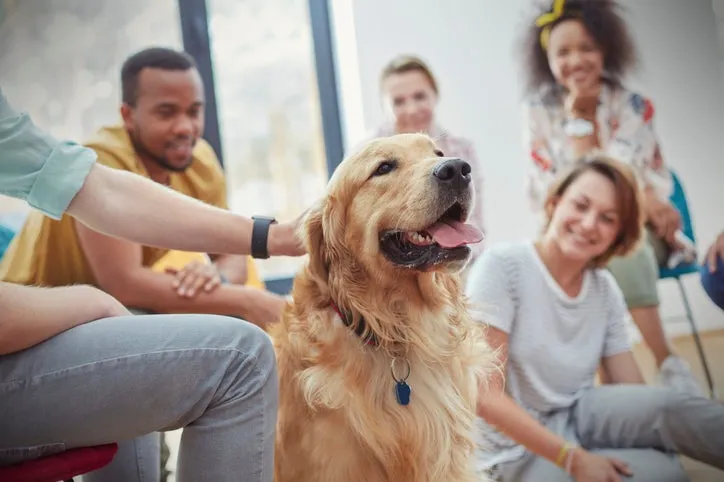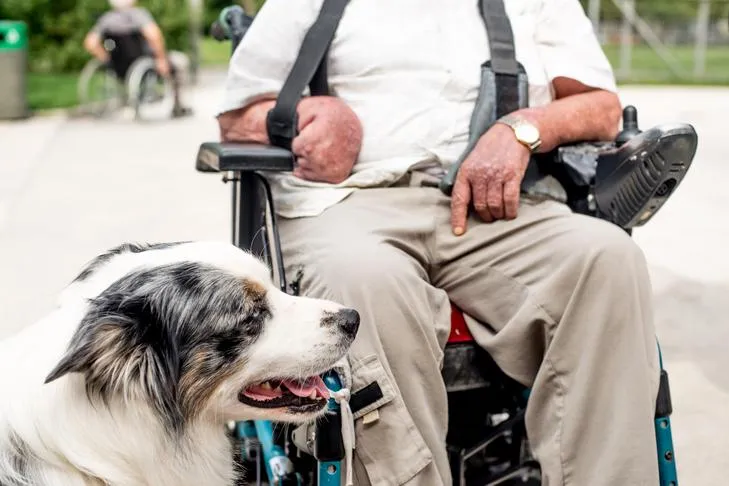In recent times, the profound health benefits of dogs have become increasingly recognized, leading to a surge in public interest surrounding therapy dogs. These remarkable canines offer solace to individuals in stressful situations, provide comfort to those experiencing grief or loneliness, and extend affectionate companionship to humans within various institutions like hospitals, nursing homes, and educational settings. If you are an owner with a friendly, well-behaved dog that genuinely enjoys interacting with people, you might be wondering How To Train Your Dog For Pet Therapy to become part of this invaluable service. Understanding the process of preparing your canine companion for such a role is crucial, encompassing temperament assessment, specific training, and official certification. Learning how to teach your dog how to come is a fundamental step in building a well-behaved companion ready for the demands of therapy work.
What Exactly Is a Therapy Dog?
A therapy dog provides comfort and affection to people in a facility setting or to specific individuals who benefit from their visitation to address a physical or emotional challenge. It’s important to distinguish therapy dogs from service dogs, which are specially trained to perform specific tasks for individuals with disabilities and are granted full public access under the Americans with Disabilities Act (ADA). They are also different from emotional support animals, which require a prescription from a mental health professional but do not necessitate special training or certifications for their role. Therapy dogs primarily serve to offer psychological or physiological therapy to others through their presence.
The Rewarding Reasons to Train a Therapy Dog
Therapy dogs offer numerous physical benefits to the humans they visit. Their presence can help lower blood pressure and heart rate, reduce patient anxiety, and increase levels of endorphins and oxytocin, promoting a sense of well-being. This positive exchange isn’t one-sided; studies have indicated that therapy dogs also benefit from their work. These devoted animals exhibit higher rates of endorphins and oxytocin compared to average family pets, suggesting mutual emotional rewards.
Linda Keehn, CPDT-KA, a therapy dog trainer, evaluator, and handler, and owner of Positive Canine Training and Services in New York, explains, “Therapy dogs go out to hospitals, nursing homes, libraries, schools, and even disaster sites. Essentially, any venue where a clientele exists and it would be helpful for the dogs to be there.” However, simply having a friendly dog isn’t enough to begin visits. Therapy dogs require certification from, and registration in, a reputable national organization. This certification marks the final step in a dedicated journey that includes a thorough temperament assessment, specialized training, and other essential prerequisites.
 A person administering a therapy dog test to a dog in an indoor setting
A person administering a therapy dog test to a dog in an indoor setting
Can Any Dog Qualify as a Therapy Dog?
While your dog may offer unconditional love, that doesn’t automatically qualify them for therapy work. Similarly, an empathetic owner might not necessarily be an ideal half of a therapy dog team without specific preparation. So, what truly makes a good therapy dog, and how does one become an effective therapy dog team?
Most organizations require therapy dogs to have reached adulthood, with many not allowing puppies under one year old to participate. Furthermore, many reputable organizations mandate that dogs pass the AKC Canine Good Citizen (CGC) test for basic obedience. Some even require a therapy-specific test in place of the CGC. Keehn, who trains and evaluates dogs for both CGC and therapy certification, emphasizes that these foundational elements are critically important for any therapy dog operating in public. A dog that cannot reliably perform commands like “leave it” or interact politely with children will not succeed in therapy roles. Commands such as how to teach a dog to sit stay and come are integral to a dog’s success in these evaluations.
Beyond age and breed, these factors are less critical. Keehn has successfully tested dogs ranging from a four-pound Yorkshire Terrier to a 13-year-old Beagle, both of whom excelled in their CGC tests. To ensure impartiality, Keehn only evaluates teams for whom she has not provided direct training. Aside from basic obedience, a therapy dog must possess a naturally social temperament, be neither excessively young nor overly boisterous, and genuinely desire the “job.”
Keehn notes, “Most dogs love jobs. Your dog’s job may just be hiking alongside you, or something else. But most dogs like some kind of job and this is a wonderful job for them to have. However, it’s not fair to give a dog a job that it doesn’t want.” This highlights the importance of observing your dog’s natural inclination towards interacting with strangers.
Determining If Your Dog is a Good Candidate
To assess if your dog would make a good therapy dog, Keehn advises owners to observe their dog closely and dispassionately. The most crucial question to ask is whether your dog truly enjoys affection from people other than yourself.
“Does the dog really enjoy interacting with new people in different scenarios?” Keehn asks. “Does it seek out attention from people and have a calm demeanor? It could be the nicest dog in your living room, but not elsewhere. Most often in a therapy situation, people just want a dog that sits next to them and lets itself be pet.” In essence, strong therapy dog candidates are inherently calm, friendly, and affectionate towards strangers. They are also proficient in basic obedience and readily adapt to new noises, environments, smells, and equipment. Most therapy dog organizations also stipulate that dogs must be healthy, well-groomed, and have regular health and wellness check-ups.
Becoming an Effective Therapy Dog Handler
Embarking on the journey of how to train your dog for pet therapy can open up new and enriching experiences for both the dog and the owner. The dog’s world expands, and together, you contribute positively to your community. Keehn recommends joining a national or local therapy chapter, which often hosts social events, allowing both you and your dog to connect with others. She also emphasizes that therapy dog work is as beneficial for the handler as it is for the dog. However, handlers must be prepared to navigate unforeseen roles.
“Getting out of yourself and giving back to the community can improve your own mental and physical health,” Keehn states. “When you’re bringing a dog to a veterans’ organization or hospital, you may be the only non-medical person they’re seeing. It may be the only real conversation they’ve had for days. Be prepared as the therapy dog handler to connect to the client. It may be helpful to take a cognitive dog training course.” Other valuable advice for handlers includes mentoring with an experienced therapy dog handler and consulting a reputable trainer for additional guidance or experience. Most therapy dog organizations also offer printed materials or websites that can aid in your preparation. Furthermore, you often have the flexibility to choose where you volunteer. If your dog thrives around children, visiting schools or libraries might be ideal. Conversely, if that’s not a good fit, home visits with the elderly could be a more suitable option.
 A therapy dog handler interacting with their dog, focusing on their bond and impact
A therapy dog handler interacting with their dog, focusing on their bond and impact
How Are Therapy Dogs Specifically Trained?
When considering how to train your dog for pet therapy, you have the option of independent training or seeking professional assistance. Keehn, who helps owners prepare their dogs to become one half of a therapy team, advises seeking out formal organizations that list well-educated trainers on their websites to guide you.
If private training proves to be too costly, Keehn suggests reviewing the AKC Canine Good Citizen (CGC) test for its ten basic commands and utilizing YouTube videos for training tips. Enrolling in a group CGC class is another excellent starting point, potentially followed by more directed and targeted classes. While these ten commands are essential for passing the CGC test, the underlying training, particularly when executed through positive reinforcement, is invaluable and fosters lifelong good behavior. Learning specific commands such as how to teach dog stay and come are vital components of this foundational training.
Keehn confirms, “Every time you interact with your dog, your dog is learning something. Reinforce the behavior you want. Keep your criteria at a level that your dog can handle. Be clear in your communication with non-verbal and verbal cues. You don’t need to touch the dog. They learn to follow their basic instincts to sit and lay down by doing what’s comfortable.” This approach emphasizes consistency, clear communication, and reward-based methods to shape desired behaviors.
 An Australian Shepherd emotional support dog sitting calmly next to its senior owner
An Australian Shepherd emotional support dog sitting calmly next to its senior owner
Essential Tips for Training a Therapy Dog
Learning how to train your dog for pet therapy is a demanding endeavor that often requires considerable effort from both the dog and the handler. It’s important to acknowledge that some of the most highly trained dogs may never be suitable therapy dogs due to their inherent temperament. Conversely, certain dogs that are initially challenging to train can flourish with the right training approach, potentially becoming exceptional therapy dogs. The information above provides a thorough look into the various aspects of training a therapy dog. To summarize the core principles and provide a solid starting point, remember to prioritize a dog’s natural calm and friendly disposition, coupled with rigorous, positive-reinforcement based obedience training. Mastering commands like how to teach your dog come here and ensuring they are comfortable in diverse environments are crucial. This dedicated journey will not only prepare your dog but also enrich your bond and allow you both to make a meaningful difference in the lives of others. Additionally, exploring methods such as teach dog to ring bell to come inside can enhance communication and refine your dog’s obedience for various situations.
By following these guidelines and committing to a thoughtful training process, you can successfully navigate how to train your dog for pet therapy, fostering a well-adjusted and compassionate companion ready to bring joy and comfort to those in need.
